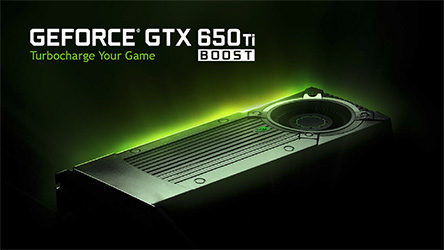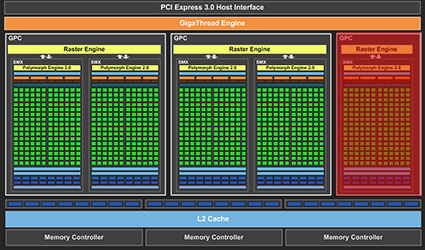 80
80
NVIDIA GeForce GTX 650 Ti Boost 2 GB Review
The Card »Introduction

It has been less than a week since a major GPU launch, AMD's Radeon HD 7790, and we already have one from NVIDIA, the GeForce GTX 650 Ti Boost. When AMD announced the Radeon HD 7950 Boost Edition in August 2012, reacting to stiff competition from NVIDIA's GeForce GTX 660 Ti, there wasn't much to lose if a consumer overlooked the "Boost" component while making the purchase, just higher clock speeds and PowerTune with Boost. The GeForce GTX 650 Ti Boost, launched today, is an extremely different beast to the original GTX 650 Ti it shares most of its name with.
NVIDIA launched the original GeForce GTX 650 Ti in October 2012 to capture the $150 price-point. The card comprehensively beat AMD's $120 Radeon HD 7770 GHz Edition in performance, which forced AMD to carve a $180 1 GB variant out of its Radeon HD 7850 that is armed with 2 GB of memory for around $210. Even as AMD carried on for six months with a gaping hole between the HD 7770 and HD 7850—a hole filled by the HD 7790 just last week—NVIDIA dug itself a hole of its own between the $150 GeForce GTX 650 Ti and the GeForce GTX 660, giving the two HD 7850 variants a free hand in the sub-$200 market, but the company rolled out the GeForce GTX 650 Ti Boost to fill exactly that gap.
Strategically priced at $170 for the 2 GB variant, with a possibility of a $150 1 GB variant in the near future, the new GeForce GTX 650 Ti Boost has its eyes set on rattling AMD's sub-$200 stronghold. So what exactly gives the "Boost" superhero powers over the GTX 650 Ti? The answer lies in the silicon. The original GTX 650 Ti uses a significantly cut down version of the 28 nm GK106 silicon. It only features 80 percent of the chip's available streaming multiprocessors, a 33% narrower memory bus, unimpressive sub-gigahertz GPU clock speed, and lacks GPU Boost—a well-implemented dynamic overclocking technology. The GeForce GTX 650 Ti Boost doesn't tinker with the streaming multiprocessor count, but utilizes the full 192-bit wide GDDR5 memory interface, GPU Boost with core clock speeds crossing the 1 GHz mark far too often, and a memory bandwidth of 144 GB/s. These three subtle changes, along with a PCB/cooler design similar to that of the GeForce GTX 660, gives the card a more premium-feel in the sub-$200 market.
The GeForce GTX 650 Ti Boost, based on the "Kepler" GPU micro-architecture, features four of the silicon's five streaming multiprocessors, which amounts to 768 CUDA cores, 64 texture memory units (TMUs), 24 raster operations processors (ROPs), and a 192-bit wide memory interface. 2 GB is the standard memory amount for now. The core features a nominal clock speed of 980 MHz that can boost itself to 1033 MHz; most real-world gaming and creativity apps should have no problems letting the chip run at that speed. The memory is clocked at 6008 MHz (GDDR5-effective), which translates into a decent 144 GB/s memory bandwidth.

In this review, we test the NVIDIA reference design GeForce GTX 650 Ti Boost. It bears an uncanny resemblance to reference boards of the GTX 660, GTX 660 Ti, and GTX 670, giving you that premium feel inside your rig.
| GeForce GTX 650 Ti | GeForce GTX 560 | Radeon HD 6870 | GeForce GTX 560 Ti | Radeon HD 7790 | Radeon HD 6950 | GeForce GTX 570 | Radeon HD 6970 | Radeon HD 7850 | GeForce GTX 650 Ti Boost | GeForce GTX 660 | Radeon HD 7870 | GeForce GTX 580 | GeForce GTX 660 Ti | |
|---|---|---|---|---|---|---|---|---|---|---|---|---|---|---|
| Shader Units | 768 | 336 | 1120 | 384 | 896 | 1408 | 480 | 1536 | 1024 | 768 | 960 | 1280 | 512 | 1344 |
| ROPs | 16 | 32 | 32 | 32 | 16 | 32 | 40 | 32 | 32 | 24 | 24 | 32 | 48 | 24 |
| Graphics Processor | GK106 | GF114 | Barts | GF114 | Bonaire | Cayman | GF110 | Cayman | Pitcairn | GK106 | GK106 | Pitcairn | GF110 | GK104 |
| Transistors | 2540M | 1950M | 1700M | 1950M | 2080M | 2640M | 3000M | 2640M | 2800M | 2540M | 2540M | 2800M | 3000M | 3500M |
| Memory Size | 1024 MB | 1024 MB | 1024 MB | 1024 MB | 1024 MB | 2048 MB | 1280 MB | 2048 MB | 2048 MB | 2048 MB | 2048 MB | 2048 MB | 1536 MB | 2048 MB |
| Memory Bus Width | 128 bit | 256 bit | 256 bit | 256 bit | 128 bit | 256 bit | 320 bit | 256 bit | 256 bit | 192 bit | 192 bit | 256 bit | 384 bit | 192 bit |
| Core Clock | 925 MHz | 810 MHz | 900 MHz | 823 MHz | 1000 MHz | 800 MHz | 732 MHz | 880 MHz | 860 MHz | 980 MHz+ | 980 MHz+ | 1000 MHz | 772 MHz | 915 MHz+ |
| Memory Clock | 1350 MHz | 1002 MHz | 1050 MHz | 1002 MHz | 1500 MHz | 1250 MHz | 950 MHz | 1375 MHz | 1200 MHz | 1502 MHz | 1502 MHz | 1200 MHz | 1002 MHz | 1502 MHz |
| Price | $140 | $170 | $170 | $200 | $150 | $170 | $250 | $380 | $180 | $170 | $215 | $220 | $310 | $280 |
Apr 8th, 2025 02:04 EDT
change timezone
Latest GPU Drivers
New Forum Posts
- 9070XT or 7900XT or 7900XTX (123)
- Kindly help in Identifying GPU and Suitable bios (9)
- AMD RX 9070 XT & RX 9070 non-XT thread (OC, undervolt, benchmarks, ...) (84)
- 12v lines 0 reads occansionally (3)
- Asus X670E Crosshair Crashes (7)
- USB case with dual USB-C and dual USB-A (7)
- The coffee and tea drinkers club. (247)
- The easiest way to connect the BOOTSEL test metal terminal and the GND terminal.... (1)
- Anyone with true HDDs still around here? (337)
- is it worth using ssd with usb2? (12)
Popular Reviews
- The Last Of Us Part 2 Performance Benchmark Review - 30 GPUs Compared
- UPERFECT UStation Delta Max Review - Two Screens In One
- ASUS Prime X870-P Wi-Fi Review
- PowerColor Radeon RX 9070 Hellhound Review
- Upcoming Hardware Launches 2025 (Updated Apr 2025)
- MCHOSE L7 Pro Review
- Sapphire Radeon RX 9070 XT Pulse Review
- Corsair RM750x Shift 750 W Review
- Sapphire Radeon RX 9070 XT Nitro+ Review - Beating NVIDIA
- DDR5 CUDIMM Explained & Benched - The New Memory Standard
Controversial News Posts
- NVIDIA GeForce RTX 5060 Ti 16 GB SKU Likely Launching at $499, According to Supply Chain Leak (161)
- MSI Doesn't Plan Radeon RX 9000 Series GPUs, Skips AMD RDNA 4 Generation Entirely (146)
- Microsoft Introduces Copilot for Gaming (124)
- AMD Radeon RX 9070 XT Reportedly Outperforms RTX 5080 Through Undervolting (119)
- NVIDIA Reportedly Prepares GeForce RTX 5060 and RTX 5060 Ti Unveil Tomorrow (115)
- Over 200,000 Sold Radeon RX 9070 and RX 9070 XT GPUs? AMD Says No Number was Given (100)
- NVIDIA GeForce RTX 5050, RTX 5060, and RTX 5060 Ti Specifications Leak (97)
- Nintendo Switch 2 Launches June 5 at $449.99 with New Hardware and Games (92)


